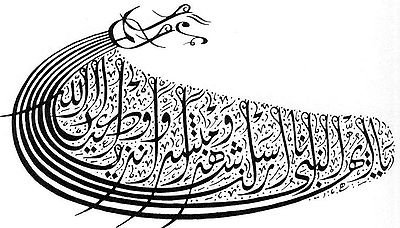Diwani
| Part of a series on |
| Islamic culture |
|---|
| Architecture |
| Art |
| Clothing |
| Holidays |
| Literature |
| Music |
| Theatre |
This article needs additional citations for verification. (December 2009) |

Diwani is a calligraphic variety of Arabic script, a cursive style developed during the reign of the early Ottoman Turks (16th century - early 17th century). It reached its height of popularity under Süleyman I the Magnificent (1520–1566).
It was labeled the Diwani script because it was used in the Ottoman diwan and was one of the secrets of the sultan's palace. The rules of this script were not known to everyone, but confined to its masters and a few bright students. It was used in the writing of all royal decrees, endowments, and resolutions. A Diwani text adorned with a tugrah, a complex calligraphic seal, represented the authority of the Sultan and the Ottoman state.[1]
The Diwani script can be divided into two types:
- The Riq`a Diwani style, which is devoid of any decorations and whose lines are straight, except for the lower parts of the letters.
- The Jeli Diwani or clear style. This kind of handwriting is distinguished by the intertwining of its letters and its straight lines from top to bottom. It is punctuated and decorated to appear as one piece. The Diwani handwriting is known for the intertwining of its letters, which makes it very difficult to read or write, and difficult to forge.


Diwani is marked by beauty and harmony, and accurate small samples are considered more beautiful than larger ones. It is still used in the correspondence of kings, princes, presidents, and in ceremonies and greeting cards, and has a high artistic value.
Mural artist and calligrapher Fatma Al Sharshani uses the script in her work, most notably in her mural Never Ending / Endless, which is located in Portland, USA.[2]
See also
[edit]References
[edit]- ^ Osborn, J.R. (2009). "Narratives of Arabic Script: Calligraphic Design and Modern Spaces". Design and Culture. 1 (3): 289–306. doi:10.1080/17547075.2009.11643292. S2CID 147422407.
- ^ "Qatari Calligrapher Fatima Al-Sharshani Collaborated With Portland Street Art Alliance on a Mural of Evocative Arabic Writing". Willamette Week. 2021-09-08. Retrieved 2025-01-22.

